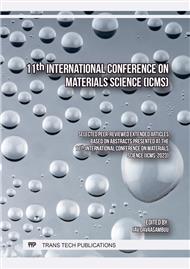[1]
Eom, K., Park, H.S., Yoon, D. S., Kwon, T., Nanomechanical resonators and their applications in biological/chemical detection: Nanomechanics principles. Physics Reports, 503.4-5 (2011) 115-163.
DOI: 10.1016/j.physrep.2011.03.002
Google Scholar
[2]
A. Boisen, S. Dohn, S.S. Keller, S. Schmid, M. Tenje, Cantilever-like micromechanical sensors. Reports on Progress in Physics, 74.3 (2011) 036101.
DOI: 10.1088/0034-4885/74/3/036101
Google Scholar
[3]
J. Mei, L. Li, Frequency self-tuning of carbon nanotube resonator with application in mass sensors. Sensors and Actuators B: Chemical, 188 (2013) 661-668.
DOI: 10.1016/j.snb.2013.07.030
Google Scholar
[4]
E. P. M. Amorim, E. Z. da Silva, Helical Gold Nanowires Make Longer Linear Atomic Chains, Phys. Rev. Lett. 101 (2008) 125502.
DOI: 10.1103/physrevlett.101.125502
Google Scholar
[5]
Q. F. Gu, G. Krauss, F. Gramm, A. Cervellino, W. Steurer, Unexpected High Stiffness of Ag and Au Nanoparticles, Phys. Rev. Lett. 100 (2008) 045502.
DOI: 10.1103/physrevlett.100.045502
Google Scholar
[6]
M. Lebrat, S. Häusler, P. Fabritius, D. Husmann, L. Corman, T. Esslinger, Quantized Conductance through a Spin-Selective Atomic Point Contact, Phys. Rev. Lett. 123 (2019) 193605.
DOI: 10.1103/physrevlett.123.193605
Google Scholar
[7]
J. Zhang, M. Tomitori, T. Arai, Y. Oshima, Surface Effect on Young's Modulus of Sub-Two-Nanometer Gold [111] Nanocontacts. Phys. Rev. Lett. 128 (2022) 146101-14.
DOI: 10.1103/physrevlett.128.146101
Google Scholar
[8]
S. D. Bennett, J. Maassen, A. A. Clerk, Scattering Approach to Backaction in Coherent Nanoelectromechanical Systems, Phys. Rev. Lett. 105 (2010) 217206.
DOI: 10.1103/physrevlett.106.199902
Google Scholar
[9]
X. Li, T. Ono, Y. Wang, M. Esashi, Ultrathin single-crystalline-silicon cantilever resonators: Fabrication technology and significant specimen size effect on Young's modulus, Appl. Phys. Lett. 83 (2003) 3081.
DOI: 10.1063/1.1618369
Google Scholar
[10]
C. Q. Chen, Y. Shi, Y. S. Zhang, J. Zhu, Y. J. Yan, Size Dependence of Young's Modulus in ZnO Nanowires, Phys. Rev. Lett. 96 (2006) 075505.
DOI: 10.1103/physrevlett.96.075505
Google Scholar
[11]
A. Sánchez-Iglesias, B. Rivas-Murias, M. Grzelczak, J. Pérez-Juste, L. M. Liz-Marzán, F. Rivadulla, M.A. Correa-Duarte, Highly transparent and conductive films of densely aligned ultrathin Au nanowire monolayers, Nano Lett. 12 (2012) 6066.
DOI: 10.1021/nl3021522
Google Scholar
[12]
S. Gong, W. Schwalb, Y. Wang, Y. Chen, Y. Tang, J. Si, B. Shirinzadeh, W. Cheng, A wearable and highly sensitive pressure sensor with ultrathin gold nanowires, Nat. Commun. 5 (2014) 3132.
DOI: 10.1038/ncomms4132
Google Scholar
[13]
R.E. Miller, V. B. Shenoy, Size-dependent elastic properties of nanosized structural elements. Nanotechnology, 11.3 (2000) 139.
DOI: 10.1088/0957-4484/11/3/301
Google Scholar
[14]
M.E. Gurtin, A. Ian Murdoch, A continuum theory of elastic material surfaces. Archive for rational mechanics and analysis, 57 (1975) 291-323.
DOI: 10.1007/bf00261375
Google Scholar
[15]
M.E. Gurtin, A.I. Murdoch, Surface stress in solids. International journal of Solids and Structures, 14.6 (1978) 431-440.
DOI: 10.1016/0020-7683(78)90008-2
Google Scholar
[16]
J. F. Nye, John Frederick. Physical properties of crystals: their representation by tensors and matrices. Oxford university press, 1985.
Google Scholar
[17]
N. W. Ashcroft, N. D. Mermin. Solid State Physics (HRW Internat. ed.), 1987.
Google Scholar
[18]
D. Sander, The correlation between mechanical stress and magnetic anisotropy in ultrathin films, Reports on Progress in Physics 62.5 (1999) 809.
DOI: 10.1088/0034-4885/62/5/204
Google Scholar
[19]
M. Liu, F. Liu, Quantum manifestation of elastic constants in nanofilms. Nanotechnology, 25.13 (2014) 135706.
DOI: 10.1088/0957-4484/25/13/135706
Google Scholar
[20]
M. De Jong, W. Chen, T. Angsten, A. Jain, R. Notestine, A. Gamst, M. Asta, Charting the complete elastic properties of inorganic crystalline compounds. Scientific data, 2.1 (2015)1-13.
DOI: 10.1038/sdata.2015.9
Google Scholar
[21]
C. Deneke, C. Müller, N.Y. Phillipp, O.G. Schmidt, Diameter scalability of rolled-up In (Ga) As/GaAs nanotubes. Semiconductor science and technology, 17.12 (2002), 1278.
DOI: 10.1088/0268-1242/17/12/312
Google Scholar



